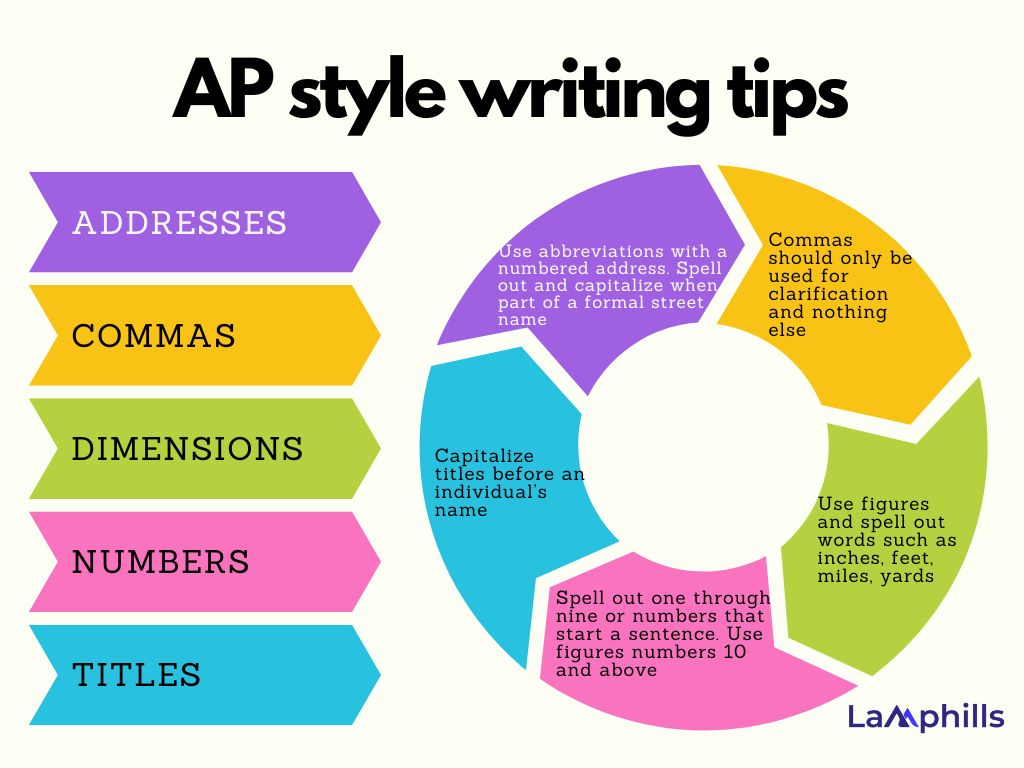Of course, you’ve heard of the AP style of writing. Every academic, journalist, and researcher has. It is to us what HubSpot is to content marketers and advertisers: the industry “Bible”.
Or at least the style it was written in.
Now, maybe you’re wondering why you should care about AP-style writing. After all, you’re not in school anymore, so no one is grading what you write. However, just because your writing is not being graded does not mean it is not being judged by your audience.
So, if you don’t know AP’s standardized punctuation and grammar conventions or how to properly use abbreviations, titles, and formal names, it’s time to brush up.
Key Points
- AP style dictates basic rules for grammar and punctuation, as well as specific styles for numbers, spelling, capitalization, abbreviations, acronyms, and much more.
- The details of the AP style can be found in the “Associated Press Stylebook and Briefing on Media Law”.
- If you don’t have an AP Stylebook at your desk or a subscription to the online version, there are a few general tips for using AP Style.
- The guiding principles behind the AP style are consistency, clarity, accuracy, and brevity.
- Content marketers can benefit from the “inverted pyramid” approach of the AP style, as it presents the most important information first.
What Is AP Style Of Writing?
Associated Press (AP) style is the go-to English style and usage guide for journalism and news writing, such as magazines and newspapers. AP style dictates basic rules for grammar and punctuation, as well as specific styles for numbers, spelling, capitalization, abbreviations, acronyms, and much more.
The ins and outs of AP style can be found in the “Associated Press Stylebook and Briefing on Media Law”.
The Associated Press was founded in 1848 by six New York newspapers who desired to share resources for international news. Newspapers saved money by sharing the news that arrived by telegraph wire and dividing the expenses evenly; this prevented competition for information.
The AP is currently the largest news-gathering organization in the world and uses its style to keep the news easy to read, concise, and free of bias. First published in 1977, The Associated Press Stylebook lists the rules regarding grammar, spelling, punctuation, and usage. The Stylebook is the standard guide for most U.S. newspapers, magazines, and other media.
While the AP style guide was originally sold as a handbook for reporters, it’s rapidly become the leading reference for the majority of public-facing communication, including websites, white papers, and press releases to reflect new additions to the English language or address common verbiage seen in the media. For instance, the latest edition included new or revised entries for digital wallets, smart devices, and the novel coronavirus.
If you’re ever in doubt about acceptable word use or modern jargon, the style guide is continuously refreshed to keep up with trends.
Purpose of the AP Style
The content of newspapers and other mass media is typically the result of many different writers and editors working together. AP style provides consistent guidelines for such publications in terms of grammar, spelling, punctuation, and language usage.
Some guiding principles behind the AP style are:
- Consistency
- Clarity
- Accuracy
- Brevity
AP style also aims to avoid stereotypes and unintentionally offensive language.
AP Style Writing Tips
If you don’t have an AP Stylebook at your desk or a subscription to the online version, here are a few general tips for using AP Style:

- Addresses. Use the abbreviations Ave., Blvd., and St. only with a numbered address (e.g., 1600 Pennsylvania Ave.). Spell them out and capitalize when part of a formal street name without a number (e.g., Pennsylvania Avenue). Spell out and capitalize First through Ninth when used as street names, but use figures for 10th and above.
- Commas. In AP style, clarity is the biggest rule. If a comma does not help clarify what is being said, it should not be there. If omitting a comma could lead to confusion or misinterpretation, then use the comma. AP style does not use the Oxford comma, so do not put a comma before the conjunction in most simple series (e.g., The American flag is red, white, and blue.).
- Dimensions. For height, weight, or other dimensions, use figures and spell out words such as inches, feet, miles, yards, etc. (e.g., The storm left 5 inches of snow.)
- Hyphens. While hyphens are far from standardized, AP style uses them to avoid ambiguity or to form a single idea from two or more words (e.g., energy-efficient products, real-time data, black-and-white photography, a big-ass fire).
- Numbers. In the AP Stylebook’s “numerals” section, the guidance is to generally spell out one through nine or numbers that start a sentence (unless it’s a year). Use figures for any numbers 10 and above or for all ages and percentages.
- Titles. AP style confines capitalization to formal titles used directly before an individual’s name (e.g., President Joe Biden). When titles are not used with an individual’s name or in constructions that set them off from a name by commas, they should be lowercase.
AP Style Writing Guide
Unless you’re prepared to invest several hours into scanning hundreds of pages in the AP style guide, it’s easier to review the most common best practices for AP style. When it comes to content marketing, best practices typically revolve around numbers, dates, citations, capitalization, and headlines.
Below is a cheat sheet containing all the necessary elements that make up the AP style of writing:
AP style cheat sheet
Benefits Of Using AP Style Writing
AP style was originally developed with print media in mind. Back in the 1950s, when the guide was first published, writing space was limited, and it was extremely costly for news outlets to correct errors. However, today, the ease of online media outlets and blogs makes available space much less of an issue.
Still, that’s not to say that many of AP’s earliest benefits for journalists don’t still benefit the content marketers of today.
For one, the continued use of the AP style means that the writing style is uniform across all outlets. This helps ensure that content marketing is easy to read and concise, so it can connect with a wide audience. Plus, it creates a writing style readers can come to expect and recognize, assisting in branding efforts.
Secondly, content marketers can benefit from the “inverted pyramid” approach of the AP style. The most important information is presented first, in the lead or introduction. Supporting information is presented lower in the copy, and the least important details are always included last.
Of course, this approach stems from the days when newspapers were printed with very limited space. With the “inverted pyramid” thought process, printers could simply cut off the bottom of a story if it didn’t fit in the allotted column. Today, content marketers should always present their audience with the most important information first.
This way, if a reader leaves the page mid-way through, they’ve at least instilled the most relevant part of their message.
AP Style Vs APA Style In Writing
When writing, it is important not to confuse the AP style of writing with the APA style.
The APA style is a set of guidelines for writing in psychology and related fields, as APA stands for the American Psychological Association. These guidelines are set down in the Publication Manual of the American Psychological Association, which originated in 1929 as a short journal article that provided basic standards for preparing manuscripts to be submitted for publication. It was later expanded and published as a book by the association and is now in its seventh edition.
The primary purpose of the APA style is to facilitate scientific communication by promoting clarity of expression and by standardizing the organization and content of research articles and book chapters. It is easier to write about research when you know what information to present, the order in which to present it, and even the style in which to present it.
Likewise, it is easier to read about research when it is presented in familiar and expected ways.
What Does APA Style Include?
The APA style has three levels. The first level dictates organization, the second level addresses writing style and language use, and the third level deals with mechanics such as punctuation.
Let’s begin with the first level.
Level 1 – Organization
An APA-style research paper must include:
- A title page – limit your title to a maximum of 12 words and avoid the use of abbreviations and unnecessary words
- An abstract– the abstract should discuss the topic under study, the research questions, any subjects of the research, your research methods, the findings/results, analysis of the data, and your conclusions
- An introduction – address the problem and premise upon which the research was based
- Your methodology – explain in detail how you did your research
- Your results – explain what you found
- A discussion – talk about what your findings mean
- References – a list of the sources you cited
There are more specific guidelines for the manuscript formatting of abstracts and title pages, many examples of which can easily be found by referring to the APA Manual of Style.
Level 2 – Writing Style
An APA-style research paper should be written formally. Your intended audience is other academics, your colleagues, and you want to communicate with them very clearly and professionally. This means:
- No slang
- No pop culture references
- No humor
- Minimize literary devices (metaphors, irony, imagery, etc.)
- Be direct and straightforward
- Use technical terms, but only where appropriate
- Avoid biased language
In other words, your writing should sound as clear and neutral as possible. It is recommended that you avoid using colorful language to try to sound fancy.
For example, if you had your research subjects jump up and down on one leg for ten minutes, say so. Don’t try to use complex phrasing like “participants utilized a unipedal movement to propel themselves off of the ground and then return to land.”
With regard to biased language, always use gender-inclusive language (firefighters vs. firemen). Use specific group labels (Asian Americans vs. minorities) and avoid euphemisms (adults with learning disabilities vs. special adults). It’s always a good idea to Google search any terms you want to use if you aren’t sure whether they are offensive or not.
Level 3 – Mechanics
APA-style manuscript formatting demands the use of double-spacing and 8.5 x 11 paper with 1-inch margins. Times New Roman 12pt font is recommended. There are a large number of specific recommendations for proper manuscript formatting of an APA-style paper, which can be found in the APA Manual of Style.
Some of the most common recommendations include:
- Use title case for headings
- Use numerals for numbers 10 and above
- Hyphenate compound adjectives that precede a noun (fact-checking organization, not fact-checking organization)
- Spell out a term before introducing its abbreviation in parentheses (the United Nations (UN))
- Left align all tables and figures
- Use in-text citations for sources
- Use footnotes sparingly
Why Should You Use the AP Style in Writing?
In the PR and marketing space, the most significant reason we utilize the AP style is to provide journalists information in a familiar style that is valuable to them. Newsrooms are shrinking across the country, and reporters have less time than ever to rework the content they’ve created into AP style. AP style writing ensures you’re helping make the job of journalists and their editors easier and more streamlined.
Since reporters and editors can gather information about your company, product or service from just about anywhere — from your website to press releases, social media posts, contributed articles, and even email newsletters and other communications — leveraging AP style increases your chances of attracting attention and allows journalists and editors to select your information for positive news coverage.
Additionally, the AP style of writing guarantees consistency and continuity across all of the written content your organization creates. Even small mistakes can negatively impact your credibility and harm your ability to be seen as a trustworthy resource in your industry.
Related Posts
Social Media Etiquette: Best Practices
How To End a Conversation Politely & Professionally: Detailed Tips
Corporate Communications: Strategies to Amplify Your Brand’s Message





